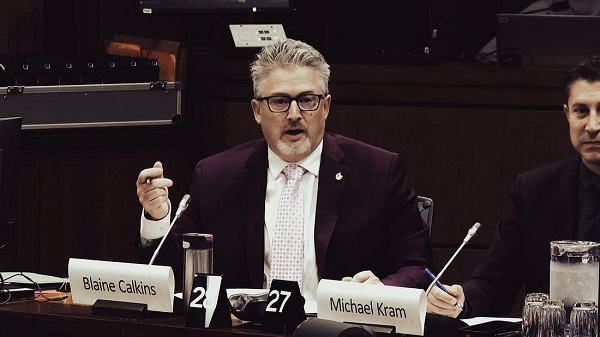Health
Medical Groupthink Makes People Sicker, Analysts Argue

From Heartland Daily News
Medicine has a huge “blind spot” that has led to an explosion of childhood obesity, diabetes, autism, peanut allergies, and autoimmune diseases in the United States, says Martin Makary, M.D., author of the bestselling book Blind Spots.
“We have the sickest population in the history of the world … right here in the United States, despite spending double what other wealthy countries spend on health care,” said Makary during a September 20 presentation at the Cato Institute, titled “Blind Spots: When Medicine Gets It Wrong, and What It Means for Our Health.” Also on the panel were Cato scholars Jeffrey A. Singer, M.D., and David A. Hyman, M.D.
Makary became well-known during the COVID-19 lockdowns as one of a small group of prominent physicians who publicly questioned the government’s response to the virus. Makary is a professor of surgery at Johns Hopkins Medicine, where he researches the underlying causes of disease and has written numerous scientific articles and two other bestselling books.
Chronic-Disease Epidemics
Makary said the rates of some diseases have reached epidemic proportions. Half of all children in the United States are obese or overweight, with 20 percent now diabetic or prediabetic. The rate of children being diagnosed with autism is up 14 percent every year for the last 23 years, one in five U.S. women have been diagnosed with an autoimmune disease, and gastrointestinal cancers have doubled in the last two decades.
“We have got to ask the big questions,” said Makary said in his remarks. “We have developed blind spots not because we’re bad people but because the system has a groupthink, a herd mentality.”
Health care has become assembly-line medicine, with health professionals pressured to focus more on productivity and billing output than on improving overall health, says Makary.
“We need to look at gut health, the microbiome, our poisoned food supply; maybe we need to look at environmental exposures that cause cancer, not just the chemo to treat it; maybe treat diabetes with cooking classes instead of throwing meds at people; maybe we need to treat high blood pressure by talking about sleep quality,” said Makary.
Sticky Theories
Hyman says cognitive dissonance can cause blind spots, highlighting an example of a surgeon initially resistant to trying less-invasive antibiotics before surgically removing an appendix, as recounted in Makary’s book.
“Easy problems are already fixed, so how do we fix this hard problem?” said Hyman at the presentation, pointing out unjustified medical opinions can persist for decades.
Such opinions include the ideas that “opioids are not addictive, or antibiotics won’t hurt you, or hormone therapy causes breast cancer even though the data never supported it, the dogma of the food pyramid,” said Makary.
“We love to hold on to old ideas not because they’re better or more logical or [more] scientifically supported than new information, but just because we heard it first,” said Makary. “And it gets comfortable. It will nest in the brain, and subconsciously we will defend it.”
Peanut Allergy Mixup
Singer asked Makary about the peanut allergy dogma the American Academy of Pediatrics pushed in 2000, recommending children not eat peanuts before the age of three. It turned out to be wrong, said Singer.
“We have peanut allergies in the U.S. at epidemic proportions, [yet] they don’t have them in Africa and parts of Europe and Asia,” said Makary. The United States “got it perfectly backward,” said Makary. “Peanut abstinence results in a sensitization at the immune-system level.”
An early introduction of peanuts reduces the incidence of people identified with peanut allergies at a rate of 86 percent, Makary told the audience.
Makary said he confronted those who argued for peanut abstinence, noting there were no studies to back up the recommendation. They replied that they felt compelled to weigh in because the public wanted something done, said Makary.
‘Demonized’ HRT
The recommendation against hormone replacement therapy (HRT) for older women because of breast cancer risk is another example of misguided groupthink, Makary told the audience.
“It is probably the biggest screw-up in modern medicine,” said Makary.
“HRT replaces estrogen when the body stops producing it,” said Makary. “Women who start it within 10 years after the onset of menopause live on average three and a half years longer, have healthier blood vessels, they will have 50 to 60 percent less cognitive decline, the risk of Alzheimer’s goes down by 35 percent. Women feel better and live longer. The rate of heart attacks goes down by half. And their bones are stronger. There is probably no medication that has a greater impact on health outcomes in populations than hormone therapy.”
A demonization campaign against HRT began 22 years ago when a single scientist at the National Institutes of Health held a press conference saying HRT was linked to breast cancer, Makary told the audience.
“The incredible back story is that no data were released at that announcement,” said Makary. “And today there is no statistically significant increase [of breast cancer].”
Political Challenges
Among the broad range of topics in the 75-minute discussion, the panelists considered how medical groupthink affects government policy.
“Agencies make decisions in the shadows of how [they think] Congress will react,” said Hyman. “Congress can make your life really miserable if you’re a federal regulator. They can cut your budget, call you in, and yell at you because you haven’t taken aggressive steps to protect the American public.”
Makary said doctors must avoid making recommendations based on “gut feelings.”
“We spend a staggering amount of money on delivering health care, and very little money on what actually works,” said Hyman.
AnneMarie Schieber ([email protected]) is the managing editor of Health Care News.
Addictions
The Shaky Science Behind Harm Reduction and Pediatric Gender Medicine


By Adam Zivo
Both are shaped by radical LGBTQ activism and questionable evidence.
Over the past decade, North America embraced two disastrous public health movements: pediatric gender medicine and “harm reduction” for drug use. Though seemingly unrelated, these movements are actually ideological siblings. Both were profoundly shaped by extremist LGBTQ activism, and both have produced grievous harms by prioritizing ideology over high-quality scientific evidence.
While harm reductionists are known today for championing interventions that supposedly minimize the negative effects of drug consumption, their movement has always been connected to radical “queer” activism. This alliance began during the 1980s AIDS crisis, when some LGBTQ activists, hoping to reduce HIV infections, partnered with addicts and drug-reform advocates to run underground needle exchanges.
The Bureau is a reader-supported publication.
To receive new posts and support my work, consider becoming a free or paid subscriber.
In the early 2000s, after the North American AIDS epidemic was brought under control, many HIV organizations maintained their relevance (and funding) by pivoting to addiction issues. Despite having no background in addiction medicine, their experience with drug users in the context of infectious diseases helped them position themselves as domain experts.
These organizations tended to conceptualize addiction as an incurable infection—akin to AIDS or Hepatitis C—and as a permanent disability. They were heavily staffed by progressives who, influenced by radical theory, saw addicts as a persecuted minority group. According to them, drug use itself was not the real problem—only society’s “moralizing” norms.
These factors drove many HIV organizations to lobby aggressively for harm reduction at the expense of recovery-oriented care. Their efforts proved highly successful in Canada, where I am based, as HIV researchers were a driving force behind the implementation of supervised consumption sites and “safer supply” (free, government-supplied recreational drugs for addicts).
From the 2010s onward, the association between harm reductionism and queer radicalism only strengthened, thanks to the popularization of “intersectional” social justice activism that emphasized overlapping forms of societal oppression. Progressive advocates demanded that “marginalized” groups, including drug addicts and the LGBTQ community, show enthusiastic solidarity with one another.
These two activist camps sometimes worked on the same issues. For example, the gay community is struggling with a silent epidemic of “chemsex” (a dangerous combination of drugs and anonymous sex), which harm reductionists and queer theorists collaboratively whitewash as a “life-affirming cultural practice” that fosters “belonging.”
For the most part, though, the alliance has been characterized by shared tones and tactics—and bad epistemology. Both groups deploy politicized, low-quality research produced by ideologically driven activist-researchers. The “evidence-base” for pediatric gender medicine, for example, consists of a large number of methodologically weak studies. These often use small, non-representative samples to justify specious claims about positive outcomes. Similarly, harm reduction researchers regularly conduct semi-structured interviews with small groups of drug users. Ignoring obvious limitations, they treat this testimony as objective evidence that pro-drug policies work or are desirable.
Gender clinicians and harm reductionists are also averse to politically inconvenient data. Gender clinicians have failed to track long-term patient outcomes for medically transitioned children. In some cases, they have shunned detransitioners and excluded them from their research. Harm reductionists have conspicuously ignored the input of former addicts, who generally oppose laissez-faire drug policies, and of non-addict community members who live near harm-reduction sites.
Both fields have inflated the benefits of their interventions while concealing grievous harms. Many vulnerable children, whose gender dysphoria otherwise might have resolved naturally, were chemically castrated and given unnecessary surgeries. In parallel, supervised consumption sites and “safer supply” entrenched addiction, normalized public drug use, flooded communities with opioids, and worsened public disorder—all without saving lives.
In both domains, some experts warned about poor research practices and unmeasured harms but were silenced by activists and ideologically captured institutions. In 2015, one of Canada’s leading sexologists, Kenneth Zucker, was fired from the gender clinic he had led for decades because he opposed automatically affirming young trans-identifying patients. Analogously, dozens of Canadian health-care professionals have told me that they feared publicly criticizing aspects of the harm-reduction movement. They thought doing so could invite activist harassment while jeopardizing their jobs and grants.
By bullying critics into silence, radical activists manufactured false consensus around their projects. The harm reductionists insist, against the evidence, that safer supply saves lives. Their idea of “evidence-based policymaking” amounts to giving addicts whatever they ask for. “The science is settled!” shout the supporters of pediatric gender medicine, though several systematic reviews proved it was not.
Both movements have faced a backlash in recent years. Jurisdictions throughout the world are, thankfully, curtailing irreversible medical procedures for gender-confused youth and shifting toward a psychotherapy-based “wait and see” approach. Drug decriminalization and safer supply are mostly dead in North America and have been increasingly disavowed by once-supportive political leaders.
Harm reductionists and queer activists are trying to salvage their broken experiments, occasionally by drawing explicit parallels between their twin movements. A 2025 paper published in the International Journal of Drug Policy, for example, asserts that “efforts to control, repress, and punish drug use and queer and trans existence are rising as right-wing extremism becomes increasingly mainstream.” As such, there is an urgent need to “cultivate shared solidarity and action . . . whether by attending protests, contacting elected officials, or vocally defending these groups in hostile spaces.”
How should critics respond? They should agree with their opponents that these two radical movements are linked—and emphasize that this is, in fact, a bad thing. Large swathes of the public understand that chemically and surgically altering vulnerable children is harmful, and that addicts shouldn’t be allowed to commandeer public spaces. Helping more people grasp why these phenomena arose concurrently could help consolidate public support for reform and facilitate a return to more restrained policies.
Adam Zivo is director of the Canadian Centre for Responsible Drug Policy.
For the full experience, please upgrade your subscription and support a public interest startup.
We break international stories and this requires elite expertise, time and legal costs.
Health
Leslyn Lewis urges Canadians to fight WHO pandemic treaty before it’s legally binding

From LifeSiteNews
Conservative MP Leslyn Lewis is urging Canadians to demand a parliamentary debate on the WHO Pandemic Agreement, highlighting risks to national sovereignty.
Conservative Member of Parliament (MP) Leslyn Lewis called on Canadians to petition against the World Health Organization’s (WHO) pandemic treaty before it becomes legally binding.
In an October 23 post on X, Lewis encouraged Canadians to demand that politicians debate the WHO Pandemic Agreement before it becomes law after warnings that the treaty could undermine national freedom and lead to global surveillance.
“I have raised red flags about its implications on Canada’s health sovereignty and the federal government’s willingness to enter a legally binding treaty of this weight without any input from Parliament,” she declared.
In May, Canada, under Liberal Prime Minister Mark Carney, adopted the treaty despite warnings that the agreement gives the globalist entity increased power in the event of another “pandemic.”
However, Lewis revealed that since the agreement has yet to be officially signed, Canada is not bound to it and can still make amendments.
“We are now in a critical window of opportunity to ask tough questions and debate the treaty before it is signed by the Minister of Foreign Affairs and binds our nation,” she explained.
Lewis encouraged Canadians to sign a petition calling for a debate of the agreement as well as contacting their local MPs to request a parliamentary review of the treaty.
Lewis revealed that Canadians’ persistent opposition to the treaty has already resulted in some of the more dangerous clauses, including restricting free speech, freedom of movement, and government surveillance, being removed from the final agreement.
“Thanks to the engagement of countless Canadians and concerned citizens around the world, the most extreme provisions in the WHO Pandemic Treaty were removed — these measures would have undermined national healthcare sovereignty and given international bureaucrats sweeping powers,” Lewis declared.
“The removal of provisions on vaccine mandates, misinformation and disinformation, censorship requirements, travel restrictions, global surveillance, and mandatory health measures happened because people paid attention and spoke up,” she continued.
Among the most criticized parts of the agreement is the affirmation that “the World Health Organization is the directing and coordinating authority on international health work, including on pandemic prevention, preparedness and response.”
While the agreement claims to uphold “the principle of the sovereignty of States in addressing public health matters,” it also calls for a globally unified response in the event of a pandemic, stating plainly that “(t)he Parties shall promote a One Health approach for pandemic prevention, preparedness and response.”
-

 Alberta9 hours ago
Alberta9 hours agoFrom Underdog to Top Broodmare
-

 Media1 day ago
Media1 day agoCarney speech highlights how easily newsrooms are played by politicians
-

 Business1 day ago
Business1 day agoThe painful return of food inflation exposes Canada’s trade failures
-

 Business11 hours ago
Business11 hours agoPaying for Trudeau’s EV Gamble: Ottawa Bought Jobs That Disappeared
-

 Business14 hours ago
Business14 hours agoCBC uses tax dollars to hire more bureaucrats, fewer journalists
-

 National12 hours ago
National12 hours agoElection Officials Warn MPs: Canada’s Ballot System Is Being Exploited
-

 Economy6 hours ago
Economy6 hours agoIn his own words: Stunning Climate Change pivot from Bill Gates. Poverty and disease should be top concern.
-

 Addictions8 hours ago
Addictions8 hours agoThe Shaky Science Behind Harm Reduction and Pediatric Gender Medicine




